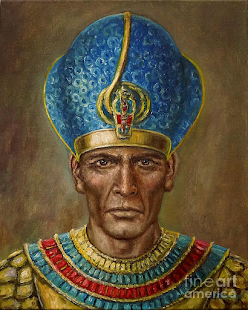Ramses III: Pharaoh of Egypt - A Legacy of Defending, Building, and Overcoming
Introduction and Early Life
Ramses III, also known as Usermaatre-Meryamun Ramses III, was the second pharaoh of the Twentieth Dynasty of Egypt. He reigned from 1186 to 1155 BC during a critical period in ancient Egyptian history. Born in the early 12th century BC, he was the son of Setnakhte, the founder of the Twentieth Dynasty, and Queen Tiy-Merenese. Ramses III was named after two of Egypt's most powerful and revered gods, Ra and Amun.
Reign and Achievements
Ramses III's reign was marked by several significant achievements, both military and architectural. One of his most notable accomplishments was his successful defense of Egypt against the Sea Peoples, a confederation of seafaring raiders who threatened the eastern Mediterranean and Egyptian territories. The Battle of the Delta, fought around 1177 BC, was a pivotal conflict during Ramses III's rule. The Egyptian forces, under his leadership, managed to repel the Sea Peoples, securing Egypt's borders and preserving its stability.
Additionally, Ramses III initiated several impressive building projects, with notable additions to Karnak Temple and Luxor Temple. He also constructed the "Harem Palace" at Medinet Habu, a grand mortuary temple on the West Bank of the Nile, dedicated to the worship of the gods and the commemoration of his reign.
The Great Harris Papyrus and Economic Challenges
The Great Harris Papyrus, an ancient Egyptian document, provides valuable insight into Ramses III's reign. It reveals details about the administration of Egypt, its economic challenges, and the pharaoh's efforts to address them. During his rule, Egypt faced economic difficulties, including the depletion of its resources and an increase in corruption and embezzlement among the high-ranking officials.
In response, Ramses III implemented various reforms to combat these issues. He introduced stronger oversight of the bureaucracy and sought to ensure that resources were properly allocated to the state's needs. His policies aimed to restore Egypt's prosperity and stabilize its economy.
Assassination and Legacy
Despite Ramses III's military and administrative successes, his reign ended in turmoil. In 1155 BC, he faced a conspiracy against his life known as the Harem Conspiracy. While the exact motivations and details remain the subject of historical debate, it is clear that a group of individuals, including some of his own family members, sought to assassinate him. Ramses III managed to survive the initial plot but was ultimately killed in the conspiracy.
Ramses III's death marked the end of a significant era in Egyptian history. He was succeeded by his son, Ramses IV. His legacy includes the preservation of Egypt's territorial integrity, the construction of monumental temples, and his efforts to restore the nation's economic stability. His mummy, which has been well-preserved, continues to be a subject of study and admiration for its detailed preservation techniques.
In conclusion, Ramses III was a pharaoh who left an indelible mark on Egypt's history. His reign was defined by both his successes in protecting Egypt and his efforts to address economic challenges. Although his life ended tragically, his legacy continues to be celebrated for his contributions to Egyptian civilization, both militarily and architecturally.




Comments
Post a Comment